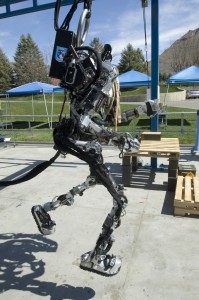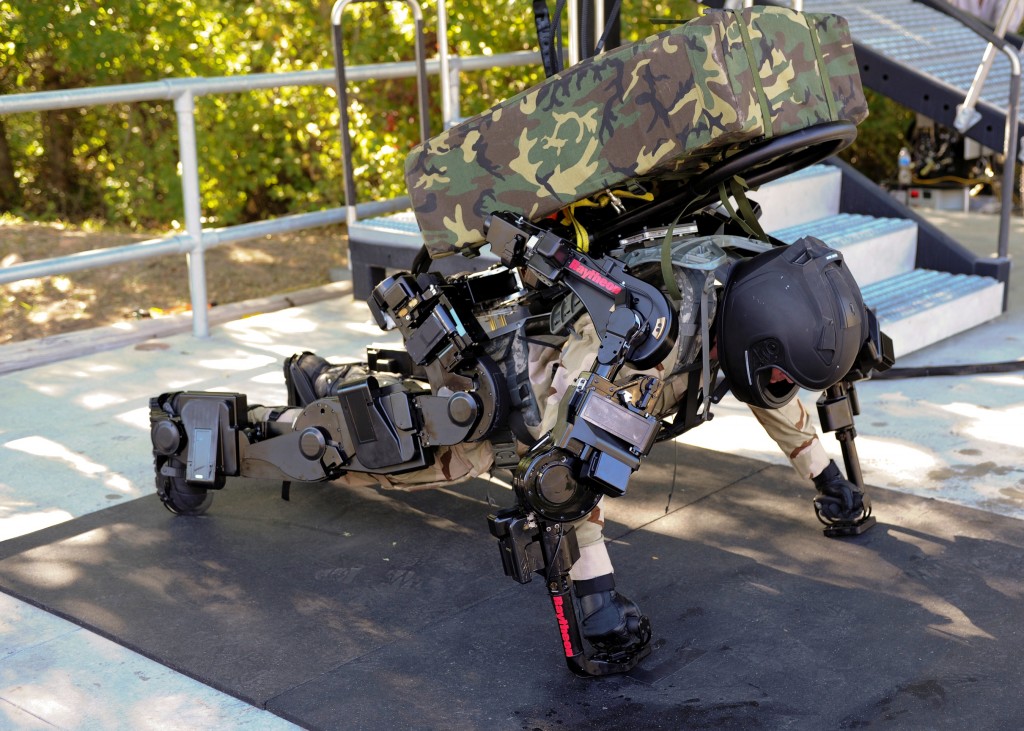
Robohub.org
Exoskeletons: New and old
With NASA’s X1 Robotic Exoskeleton in the news today, it’s timely to look at the increasing range of exoskeletons in development or use today.
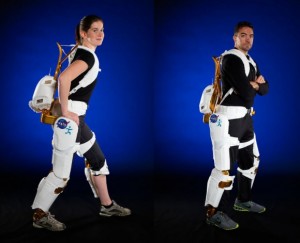 Built in conjunction with the Florida Institute for Human and Machine Cognition (IHMC), the X1 Robotic Exoskeleton weighs 57-pounds and has ten joints, four of which are motorized. However, while the X1 can work to augment the wearer’s movements, it can also be set to work against them. While X1 is still in the research and development stage, it is more likely to join other exoskeletons in use on Earth, like those from Ekso, Rex, Raytheon, Cyberdyne, Honda, MIT, and DARPA projects, than it is to assist humans in space. [Release 12-239 NASA]
Built in conjunction with the Florida Institute for Human and Machine Cognition (IHMC), the X1 Robotic Exoskeleton weighs 57-pounds and has ten joints, four of which are motorized. However, while the X1 can work to augment the wearer’s movements, it can also be set to work against them. While X1 is still in the research and development stage, it is more likely to join other exoskeletons in use on Earth, like those from Ekso, Rex, Raytheon, Cyberdyne, Honda, MIT, and DARPA projects, than it is to assist humans in space. [Release 12-239 NASA]
Ekso (Ekso Bionics)
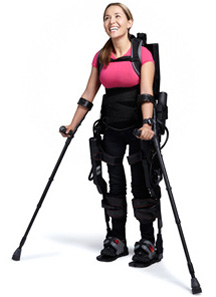 The Ekso supports its own 20-kilogram weight via the skeletal legs and footrests and takes care of the calculations needed for each step. In a later model the walking sticks will have motion sensors that communicate with the legs, allowing the user to take complete control. Ekso Bionics initially developed systems for use by able bodied people, starting with the ExoHiker in 2005 and then the HULC, or Human Universal Load Carrier, which was licensed to Lockheed Martin for military development. For more, have a look at Automaton 2012.
The Ekso supports its own 20-kilogram weight via the skeletal legs and footrests and takes care of the calculations needed for each step. In a later model the walking sticks will have motion sensors that communicate with the legs, allowing the user to take complete control. Ekso Bionics initially developed systems for use by able bodied people, starting with the ExoHiker in 2005 and then the HULC, or Human Universal Load Carrier, which was licensed to Lockheed Martin for military development. For more, have a look at Automaton 2012.
HAL 5 (Cyberdyne)
 Full hospital trials of the HAL 5 suit from Cyberdyne began this year and are expected to conclude by 2015, although you can currently rent one for approx $2000/month. The Hybrid Assistive Limb (HAL 5) is capable of boosting the wearer’s strength 5 to 10 fold and more than 300 have been leased to a range of facilities in Japan. [The Australian]
Full hospital trials of the HAL 5 suit from Cyberdyne began this year and are expected to conclude by 2015, although you can currently rent one for approx $2000/month. The Hybrid Assistive Limb (HAL 5) is capable of boosting the wearer’s strength 5 to 10 fold and more than 300 have been leased to a range of facilities in Japan. [The Australian]
Rex (Rex Bionics)
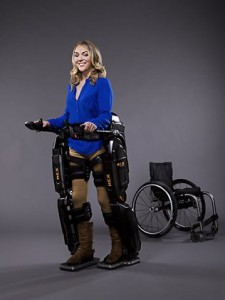 Rex Bionics founder, Richard Little was inspired to work on exoskeletons in 2003 when a friend was diagnosed with multiple sclerosis. The carbon fibre Rex costs about $150,000 NZ and weighs 38k but can give movement, including the ability to climb stairs, back to paraplegics like British TV presenter Sophie Morgan and BBC correspondant, Frank Gardner. [HeraldSun]
Rex Bionics founder, Richard Little was inspired to work on exoskeletons in 2003 when a friend was diagnosed with multiple sclerosis. The carbon fibre Rex costs about $150,000 NZ and weighs 38k but can give movement, including the ability to climb stairs, back to paraplegics like British TV presenter Sophie Morgan and BBC correspondant, Frank Gardner. [HeraldSun]
SARCOS (Raytheon)
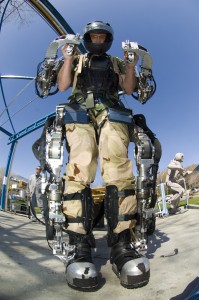 Back in 2000 US Agency DARPA requested design proposals for “Powered Military Exoskeletons” and subsequently awarded Raytheon robotics branch SARCOS with the grant.
Back in 2000 US Agency DARPA requested design proposals for “Powered Military Exoskeletons” and subsequently awarded Raytheon robotics branch SARCOS with the grant.
The result was the XOS Exoskeleton. It is powered by a single combustion engine which in turn powers the exoskeleton’s servo motors. At 68 kg (150 pounds) the bionic suit is very heavy – but reportedly allows its user to lift 90kg (about 200 pound) payloads “repeatedly with minimal strain”.
The project’s initial goal was an exoskeleton for logistics and supply tasks, but it’s easy to see various possible customizations for combat (e.g., transport and use of heavy weaponry) or battlefield operations (e.g., transport of wounded soldiers).
Others
There are a number of other exoskeletons, including perhaps this robotic wheelchair from Chiba Institute of Technology. Where is the dividing line between an exoskeleton and a vehicle?
Andra Keay from San Francisco and Markus Waibel from Zurich contributed to this post.
If you liked this article, you may also be interested in:
- Ekso Bionics goes public for $20.6 million
- 7 consumer robots to look out for from CES 2014
- Medical robotic systems market to reach $13.6 billion by 2018
- Activelink Power Loader gives HAL some competition, but who’s going to Fukushima?
See all the latest robotics news on Robohub, or sign up for our weekly newsletter.
tags: Cyberdyne, Ekso, exoskeleton, IHMC, NASA


